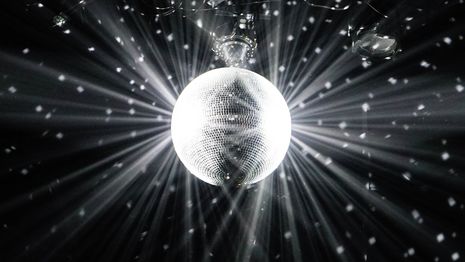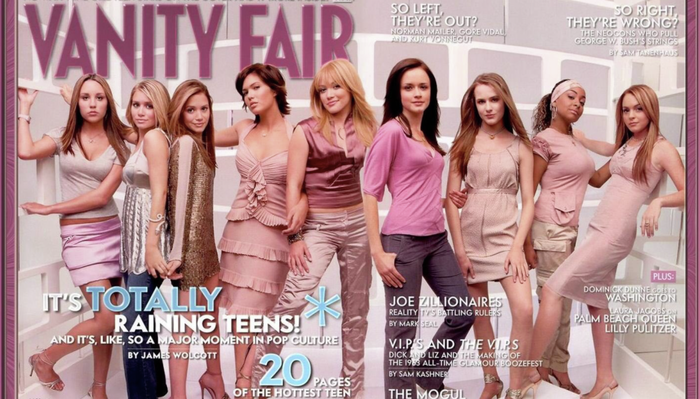Disco Balls, Bell Bottoms and Studio 54
Holly Sewell takes a dive into ’70s disco fashion and examines the legacy of the famed New York nightclub at the helm of the cultural movement.

In a small underground scene, in the midst of the economic chaos of 1970 New York, a new era of liberation emerged. Live rock musicians became a spectacle of the past, seating areas of clubs were replaced by dance floors, and traditional social barriers were blurred; disco had been born. The squalid state of downtown New York led the white middle class to flee to the suburbs, and the disco floor became a place of empowerment for communities that didn’t have the means to escape so easily. Pioneered and inspired by black, female musicians, the soundtrack to the ’70s signified inclusion and freedom for many who had been consistently persecuted by Western culture in the past. In particular, the sexual liberation of both the gay community and of women in general was embodied utterly by the fashion that took disco-goers by storm.
One of the most striking aspects of popular ’70s disco clothing was its androgyny. Flared trousers, or ‘bell bottoms’, were a staple for dancers of any gender, along with outrageous platform boots to catch the eye of any prospective dance partners. In a way, this was a nod to the subversion of gender expectations that was going on at the time. Fashion was, as ever, intrinsically linked with the music industry – the perfect example of a musical counterpart to this was Macho Man by Village People. The group repeatedly pushed boundaries and disregarded social norms in their work, and undoubtedly acted as a catalyst for gay liberation. The idea of a ‘macho man’ had been turned totally upside-down by the new wave of social integration, as is epitomised in the immortal three-piece white suit donned by John Travolta in Saturday Night Fever. Despite the controversy of the film itself because of its whitening of disco and its maybe-critical, maybe-dangerous portrayal of its characters, this outfit (designed by Patrizia von Brandenstein) has come to be described by many as one that defined the decade. Its feminine shape, cheap polyester feel and total disinterest in practicality in favour of theatrics stay completely true to the hedonistic spirit of disco. Yet, as the era drew to a close, von Brandenstein’s masterpiece became a remnant of attitudes past; the materialistic ’80s were unforgiving of its cheap construction, and new conservative values had no time for its outlandishness.
“Similar to the more protest-driven ideas behind menswear, what could easily be interpreted as a time of self-indulgent party outfits was actually a realisation of wider political themes through fashion.”
While menswear had come to depict a new, more flexible version of masculinity, womenswear was often focused on the reclamation of sex and the female body. Donna Summer’s Love to Love You Baby is a 17-minute ode to female sexual pleasure; a radical piece of expression that reached #2 on Billboard in 1976. The analogues of this in fashion were absolutely central to the ’70s disco silhouette. Gold lamé, lycra jumpsuits, and halter tops with plunging necklines were paired with figure-hugging bottoms to exaggerate the bodies of dancers under the disco ball. The highlighting of female bodies through metallic fabrics, sequin bandeau tops and an abundance of glitter represented empowerment and a sense of sheer joy. It’s interesting to note the parallels between this and the overall cultural reform of the time, since it was during the 1970s that second-wave feminism really began to pick up steam. Similar to the more protest-driven ideas behind menswear, what could easily be interpreted as a time of self-indulgent party outfits was actually a realisation of wider political themes through fashion.
Although the roots of disco lie in inclusivity and freedom, it relied more and more on exclusivity as it was picked up by the mainstream – and nothing said ‘exclusive’ like the legendary Studio 54. Created by Steve Rubell and Ian Schrager in 1977, this illustrious nightclub was all about who you were, what you looked like, and whether you’d be able to get in (probably not). Aside from being an A-List celebrity, entry could only be gained through the most phenomenal of outfits; the point was to stand out. For this reason, the club was a haven for fashion designers looking to showcase their work, but also to find inspiration.
The king of these designers was undoubtedly Halston. Among his clientele were Bianca Jagger, Liza Minnelli and Pat Cleveland, all of whom were regulars at Studio 54 and set the gold standard in terms of attire (Jagger was famously photographed on her birthday, wearing a luxurious red Halston maxi dress, atop a white horse during Studio’s opening week). Halston broke boundaries in his impossible elegance, taking minimalism to a new level in his ultra-suede and cashmere designs – whose purpose was to elevate their wearer, rather than outshine them. He opted for kimonos, kaftans and simplicity of fabric in his work, creating garments that practically dripped from the bodies of his clients. Tragically, his immense impact was short-lived. Following the abrupt closure of Studio 54 in 1980, he gradually lost control of his brand and his addiction issues, dying in 1990 as the result of AIDS-related cancer – but he nonetheless changed the shape of American fashion.
The more traction disco gained, the more hate it attracted. On Disco Demolition Night in 1979, 70,000 people took the chance to push back on the progressive set of social dynamics that had been established during the ’70s by detonating their collected disco records in Chicago’s Comiskey Park. A riot followed. Disco had been irreversibly tainted. As lockdown begins to lift throughout 2021, and with the possibility of nightclubs reopening finally in sight, the novelties of the first discos seem to be knocking once again. That these will come with the scale of social change and innovation that they did 45 years ago seems unlikely – but their rebirth is exciting, and will no doubt have an influence on our fashion in the years to come.
 News / CUP announces funding scheme for under-represented academics19 December 2025
News / CUP announces funding scheme for under-represented academics19 December 2025 News / SU reluctantly registers controversial women’s soc18 December 2025
News / SU reluctantly registers controversial women’s soc18 December 2025 News / Cambridge welcomes UK rejoining the Erasmus scheme20 December 2025
News / Cambridge welcomes UK rejoining the Erasmus scheme20 December 2025 Features / Should I stay or should I go? Cambridge students and alumni reflect on how their memories stay with them15 December 2025
Features / Should I stay or should I go? Cambridge students and alumni reflect on how their memories stay with them15 December 2025 Film & TV / Timothée Chalamet and the era-fication of film marketing21 December 2025
Film & TV / Timothée Chalamet and the era-fication of film marketing21 December 2025










